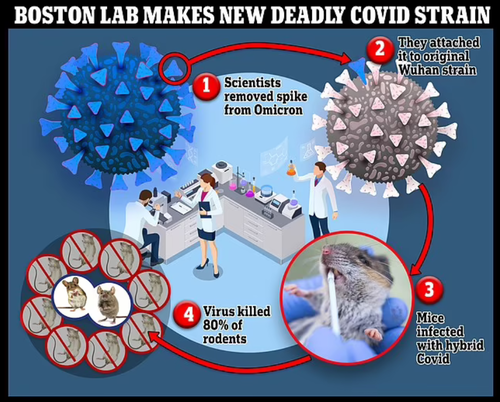Researchers have made a huge breakthrough in data transmission via fiber optics by using a single computer chip to transfer 1.84 petabits of data per second
Boston University Creates COVID Strain With 80% Mortality In Mice
Boston University Creates COVID Strain With 80% Mortality In Mice
Researchers at Boston University have created a new strain of Covid-19 that has an 80% kill rate in humanized mice.
In an effort to research what makes Omicron so transmissible – and funded in part by grants from the NIH and Anthony Fauci’s NIAID, the researchers cobbled the Omicron spike protein to the original strain of Covid-19. The resulting virus was five times more infectious than Omicron.
"The Omicron spike (S) protein, with an unusually large number of mutations, is considered the major driver of these phenotypes. We generated chimeric recombinant SARS-CoV-2 encoding the S gene of Omicron in the backbone of an ancestral SARS-CoV-2 isolate and compared this virus with the naturally circulating Omicron variant," reads the pre-print.
Role of spike in the pathogenic and antigenic behavior of SARS-CoV-2 BA.1 Omicronhttps://t.co/Zpt1LVtUuy
— Paul D. Thacker (@thackerpd) October 17, 2022
The new research, which has not been peer-reviewed, was conducted by a team from Boston and Florida.
"In…mice, while Omicron causes mild, non-fatal infection, the Omicron S-carrying virus inflicts severe disease with a mortality rate of 80 percent," the researchers wrote, adding that while the spike protein is responsible for infectivity, changes to other parts of its structure are responsible for its deadliness.
Researchers attached Omicron’s spike to the original wildtype strain that first emerged in Wuhan at the start of the pandemic.
The researchers looked at how mice fared against the new hybrid strain compared to the original Omicron variant. –Daily Mail
The researchers also looked at the effect of different strains on human lung cells grown in the lab – which Covid latches on to before instructing healthy cells to make copies of itself. They found that the modified strain produces five times more viral particles than the original Omicron strain (which all the rodents survived).
This study provides important insights into Omicron pathogenicity. We show that spike, the single most mutated protein in Omicron, has an incomplete role in Omicron attenuation. In in vitro infection assays, the Omicron spike-bearing ancestral SARS-CoV-2 (Omi-S) exhibits much higher replication efficiency compared with Omicron. Similarly, in K18-hACE2 mice, Omi-S contrasts with non-fatal Omicron and causes a severe disease leading to around 80% mortality. This suggests that mutations outside of spike are major determinants of the attenuated pathogenicity of Omicron in K18-hACE2 mice. Further studies are needed to identify those mutations and decipher their mechanisms of action. –Biorxiv
According to the scientists, however, their chimeric virus is unlikely to be as deadly in humans as it was in the mice because the specific breed used in testing are more susceptible to severe Covid.
Last year we reported that 18 months before the pandemic, scientists in Wuhan, China submitted a proposal to release enhanced airborne coronaviruses into the wild in an effort to inoculate them against diseases that could have otherwise jumped to humans, according to The Telegraph, citing leaked grant proposals from 2018.
The bid was submitted by zoologist Peter Daszak of US-based EcoHealth Alliance, who was hoping to use genetic engineering to cobble "human-specific cleavage sites" onto bat Covid ‘which would make it easier for the virus to enter human cells’ – a method which would coincidentally answer a longstanding question among the scientific community as to how SARS-CoV-2 evolved to become so infectious to humans.
Daszak’s proposal also included plans to commingle high-risk natural coronaviruses strains with more infectious, yet less deadly versions. His ‘bat team’ of researchers included Dr. Shi Zhengli from the Wuhan Institute of Virology, as well as US researchers from the University of North Carolina and the US Geological Survey National Wildlife Health Center.
Darpa refused the contract – saying "It is clear that the proposed project led by Peter Daszak could have put local communities at risk," while warning that Daszak hadn’t fully considered the dangers involved in enhancing the virus via gain-of-function research, or by releasing a vaccine into the air.
Tyler Durden
Mon, 10/17/2022 – 15:20
10 of the Best Places to See the Northern Lights in the U.S.

If witnessing amazing natural phenomenon is something you enjoy, you need to see the northern lights at some point in your life. Formally known as aurora borealis, these colorful displays of light can be seen in many northern locations around the world. Here’s how they are produced, as Travel and Leisure describes:
Alan Moore Says Batman Leads To Fascism
Alan Moore says an adult obsession with comic books like Batman is a warning sign of fascism.
The post Alan Moore Says Batman Leads To Fascism appeared first on GIANT FREAKIN ROBOT.
Relax and Have a Nice Cup of Teeth

Halloween is just around the corner and what better way to add a little spooky decor than to 3D print [DaveMakesStuff]’s Teeth Cup. It looks like [DaveMakesStuff] has done the …read more
To Find Alien Life, Scientists Suggest Searching Space for This Party Drug
Party on, Planets If the concept of space itself isn’t trippy enough for you, we have good news — scientists believe that there could well be nitrous oxide, better known as whippets or laughing gas, somewhere out there. As scientists at the University of California Riverside suggest in a new paper published in the Astrophysics Journal, […]
porous terracotta air conditioning system ‘nave’ uses water to cool spaces without electricity
the system is customizable and modular, consisting of free-standing, wall-mounted units that can be fitted to any part of the house.
The post porous terracotta air conditioning system ‘nave’ uses water to cool spaces without electricity appeared first on designboom | architecture & design magazine.
Monsters Are Everywhere in the Bible—And Some Are Even Human
This story was originally published on The Conversation and appears here under a Creative Commons license.
What is a “monster”? For most Americans, this word sparks images of haunted houses and horror movies: scary creations, neither human nor animal, and usually evil. But it can be helpful to think about “monsters” beyond these knee-jerk images. Ever since the 1990s, humanities scholars have been paying close attention to “monstrous” bodies in literature: characters whose appearance challenges common ideas about what’s normal.
Biblical scholars like me have followed in their footsteps. The Bible is full of monsters, even if they’re not Frankenstein or Bigfoot, and these characters can teach important lessons about ancient authors, texts and cultures. Monsterlike characters—even human ones—can convey ideas about what’s considered normal and good or “deviant,” disturbing, and evil.
Sometimes, monsters’ bodies are depicted in ways that reflect racist or sexist stereotypes about “us” versus “them.” Literary theorist Jack Halberstam, for example, has written about how Dracula and other vampires reveal antisemitic symbolism—even on Count Chocula cereal boxes. Such images often draw on antisemitic tropes that have been around for centuries, portraying Jewish people as shadowy, bloodsucking parasites.
Biblical monsters are no less revealing. In the Book of Judges, for example, the judge Ehud confronts the grotesque Moabite king Eglon, who is fatally fat and dies in an explosion of his own feces when a sword gets stuck in his stomach–though most modern translations render this a bit more chastely: “[Eglon’s] fat closed over [Ehud’s] blade, and the hilt went in after the blade—for he did not pull the dagger out of his belly—and the filth came out.”
In describing Eglon, the text also teaches Israelites how to think about their Moabite neighbors across the Jordan River. Like their emblematic king, Moabites are portrayed as excessive and disgusting—but ridiculous enough that Israelite heroes can defeat them with a few tricks.
Figures like Eglon and the famous Philistine giant Goliath, who battles the future King David, offer opportunities for biblical authors to subtly instruct readers about other groups of people that the authors consider threatening or inferior. But the Bible sometimes draws a relatable human character and then inserts twists, playing with the audience’s expectations.

In my own recent work, I have suggested that this is exactly what’s going on with the Book of Job. In this mostly poetic book of the Bible, “The Satan” claims that Job acts righteously only because he is prosperous and healthy. God grants permission for the fiend to test Job by causing his children to be killed, his livestock to be stolen and his body to break out in painful boils.
Job is then approached by three friends, who insist that he must have done something to prompt this apparent punishment. He spends the rest of the book debating with them about the cause of his torment.
The book is full of monsters and already a familiar topic in monster studies. In chapters 40-41, God boasts about two superanimals that he has created, called Leviathan and Behemoth. A mysterious, possibly maritime monster called Rahab appears twice. Both Job and his friends refer to vague nighttime visions that terrify them.
And of course there’s another “monster,” too: Job’s test is instigated by “the Satan.” Later in history, this figure became the archfiend of Jewish and Christian theology. In the Book of Job, though, he’s simply portrayed as a crooked minion, a shifty member of God’s heavenly court.
But I’d argue there’s another “monster” hiding in plain sight: the man at the center of it all. As biblical scholars like Rebecca Raphael and Katherine Southwood have pointed out, Job’s body is central to the book’s plot.
Job stoically tolerates Satan’s attacks on his livestock and even his children. It is only after the second attack, which produces “a severe inflammation on Job from the sole of his foot to the crown of his head,” that he lets out a deluge of complaints.
To illustrate his suffering, Job repeatedly describes his bodily decay with macabre, gruesome images: “My skin, blackened, is peeling off me. My bones are charred by the heat.” And, “My flesh is covered with maggots and clods of earth; My skin is broken and festering.” Job’s body is so transformed that he, too, can be seen as a “monster.” But while Job might think that the deity prefers ideal human bodies, this is not necessarily the case.
In the book’s telling, God sustains unique, extraordinary monsters who would seem, at first glance, to be evil or repellent—but actually serve as prime examples of creation’s wonder and diversity. And it is Satan, not God, who decides to test Job by afflicting him physically.
Some books in the Bible indeed view monsters as simplistic, inherently evil “others.” The prophet Daniel, for example, has visions of four hybrid beasts, including a winged lion and a multiheaded leopard. These were meant to symbolize threatening ancient empires that the chapter’s author despised.
The Book of Job does something radical by pushing against this limited view. Its inclusive viewpoint portrays the “monstrous” human as a sympathetic character who has his place in a diverse, chaotic world—challenging readers’ preconceptions today, just as it might have thousands of years ago.
Madadh Richey is an assistant professor of Hebrew Bible at Brandeis University.
Tesla Unveils New Dojo Supercomputer So Powerful It Tripped the Power Grid
It only had its first chip and training tiles, and it was still working on building a full Dojo cabinet and cluster or “Exapod.” Now Tesla has unveiled the progress made with the Dojo program over the last year during its AI Day 2022 last night.
Tesla can fit two of these system trays with host assembly into a single Dojo cabinet.
Brilliant Star Trails Sweep Above a Fierce Tangle of Lightning in a Striking Photo
Back in June, Marc Sellés Llimós photographed multiple instances of illumination in a single nighttime sky. From the village of Manlleu, Osona, where he lives and works, Sellés Llimós captured a fierce thunderstorm as it raged on the other side of the Serra de Bellmunt mountain in Carcassonne, France. The 380-image composite shows a brilliant tangle of lightning below sweeping star trails, produced with a slow, six-minute exposure. According to NASA, which featured the work as one of its astronomy photos of the day, the trails reflect the Earth’s daily rotation around its axis, and the extent of their curvatures represents the distance from the north pole. More
See the horror of the sun up close from world’s most powerful solar telescope
The astronomy community has a new tool for studying the sun, with the inauguration this week of the world’s largest solar telescope.
When bitcoin plunges, Buttcoin cheers: the online community praying for the end of crypto












